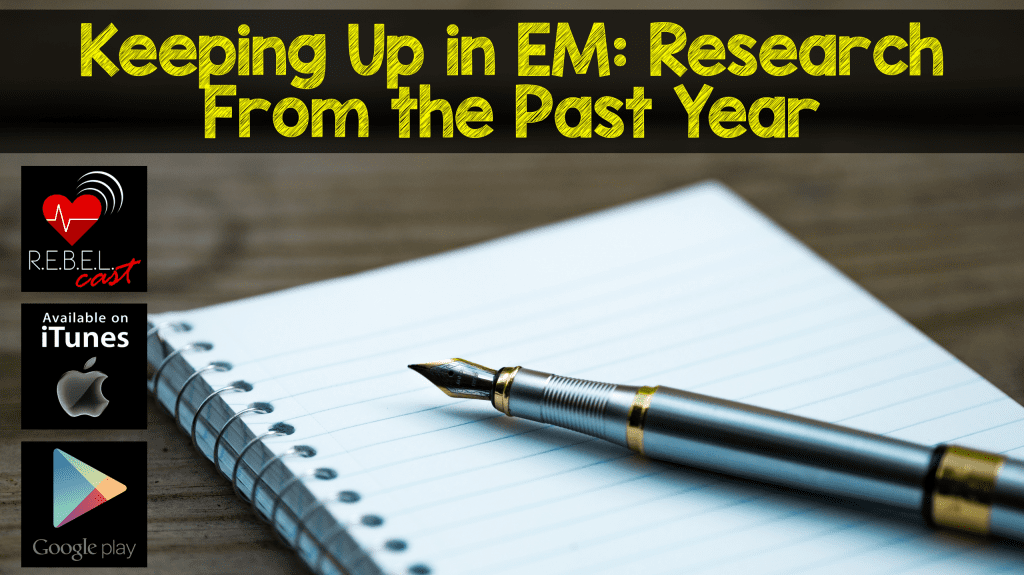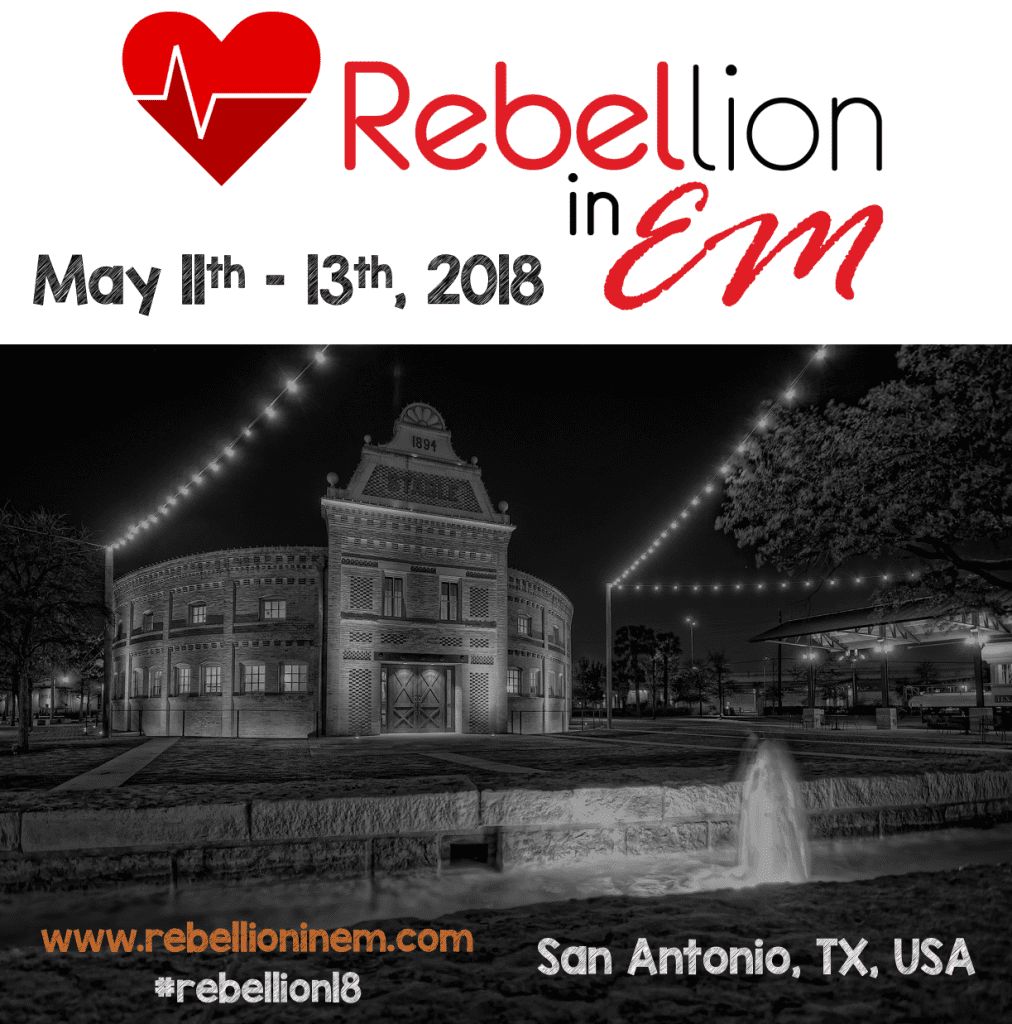
 Welcome back to Episode 42 of REBEL Cast. In this episode, we will be discussing some studies from the past year that had some interesting results and a couple of papers that are potentially going to change our practice in the near future (In the Pipeline). Again, this 3 part series will be dedicated to discussing current literature and how it can be applied to your clinical practice.
Welcome back to Episode 42 of REBEL Cast. In this episode, we will be discussing some studies from the past year that had some interesting results and a couple of papers that are potentially going to change our practice in the near future (In the Pipeline). Again, this 3 part series will be dedicated to discussing current literature and how it can be applied to your clinical practice.
Episode 42 – Research From the Past Year – In the Pipeline
Click here for Direct Download of Podcast
Study #1:
Caputo N et al. EmergeNcy Department use of Apneic Oxygenation Versus Usual Care During Rapid Sequence Intubation: A Randomized Controlled Trial (The ENDAO Trial). Acad Emerg Med 2017 PMID: 28791755
Blog Post HERE: The ENDAO Trial – Is Apneic Oxygenation a Futile Intervention in ED RSI?
- RCT in ED 200 pts
- Mean Lowest SpO2:
- ApOx: 92%
- No ApOx: 93%
- Both groups preoxygenated for 13 minutes
- Over 70% of patients were successfully intubated by 60 seconds, 80% by 80 seconds, 90% by 100seconds, and 100% by 195 seconds
- Bottom LIne: In patients who receive proper pre-oxygenation (3min with flush 100% O2), apneic oxygenation may be a superfluous intervention, however it is important to remember that AO is not a complicated procedure, not expensive, and has not been shown to be harmful. Additionally, the absence of benefit here doesn’t mean there is no group who won’t benefit (i.e. prolonged apnea times and crash intubations) but, it is nearly impossible to make accurate prospective predictions as to which patients will benefit the most.
Study #2:
Marik P et al. Hydrocortisone, vitamin C, and Thiamine for the Treatment of Severe Sepsis and Septic Shock: A Retrospective Before-After Study. Chest 2017. PMID: 27940189
Blog Post HERE: The Marik Protocol – Have We Found a “Cure” for Severe Sepsis and Septic Shock
- Retrospective Before and After Study of 94 pts
- No Vitamin C Protocol vs Vitamin C Protocol
- Duration of Vasopressors 3hr vs 54.9hr (<1d vs 2d)
- Hospital Mortality: 40.4% vs 8.5% (NNT = 3)
- The exact dosing strategy for Vitamin C is unknown, as it is not that well studied. The authors conclude that up to 6g daily should be enough without running the risk of conversion to oxalate and potentially causing worsening renal impairment from oxalate deposition.
- In this trial the exact dosing was:
- Vitamin C 1.5g q6hrs x4days
- IV hydrocortisone 50mg q6hr x7d or ICU DC + a 3 day taper
- IV thiamine 200mg q12hr x4d or ICU DC
- Bottom Line: Although the results of this study are very promising, it is important to remember that this is only a hypothesis generating study. We still need an external validation before implementation (How many other treatments in sepsis have been touted as a “cure” and not panned out in subsequent studies?).
Study #3:
Aycock RD et al. Acute Kidney Injury After Computed Tomography. A Meta-Analysis. Ann Emerg Med 2017. PMID: 28811122
Blog Post HERE: Is Contrast Induced Nephropathy (CIN) Really Not a Thing?
- Systematic Review and Meta-Analysis
- 28 Studies with over 107,000 patients (No RCTs)
- IV Contrast vs no IV Contrast Enhanced CTs:
- Not Associated with more AKI (Primary Outcome 26 studies): OR 0.94 (95% CI 0.83 – 1.07)
- Not Associated with more Renal Replacement Therapy (13 studies): OR 0.83 (95%CI 0.59 – 1.16)
- Not Associated with Increased Mortality (9 studies): OR 1.0 (95% CI 0.73 – 1.36)
- Early contrast agents used mono-iodinated rings and ionic monomers making Hyperosmolar solutions (1500mOsm) relative to serum are severe irritants and more likely to cause vasodilation, increased capillary permeability, and mast cell degranualation
- Newer lower and iso osmolar (290 – 800mOsm) contrast agents use di- and tri-iodinated rings with non-ionic monomer…90 – 95% of iodinated contrast media used in US
- High: 1500mOsm
- Low: 320 – 800mOsm
- Iso: 290mOsm
- Many studies fail to account for the patients’ other risk factors for development of acute kidney injury, including sepsis, dehydration, end-organ dysfunction, or administration of nephrotoxic medications
- Bottom Line: While a prospective, multi center RCT would put this question to rest, it’s unlikely to be feasible to perform. Based on the best available evidence, use of IV low- and iso-osmolar contrast media does not appear to be associated with increased risk of AKI, need for renal replacement therapy, or mortality.
Study #4:
Khanna A et al. Angiotensin II for the Treatment of Vasodilatory Shock. ATHOS-3. NEJM 2017 PMID: 28528561
- RCT of 404 patients angiotensin II vs placebo in patients requiring high dose norepi >0.2mcg/kg/min or equivalent vasopressor for ≥6hrs but ≤48hrs
- Angiotensin II has various effects from potentiating sympathetic activity, direct vasoconstriction, and fluid retention directly and indirectly (via release of aldosterone and vasopressin/antidiuretic hormone).
- Response in MAP: A response was defined as an increase in MAP of at least 10 mm Hg from baseline or a MAP of at least 75 mm Hg without an increase in baseline vasopressor infusions.
- Response in MAP:
- Angiotensin II: 69.9%
- No Angiotensin II: 23.4%
- NNT = 2
- Study powered to show improvement in blood pressure, a clinically important parameter, but underpowered to demonstrate a mortality difference, a patient oriented outcome
- Bottom Line: Angiotensin II added to high dose norepinephrine infusion (>0.2mcg/kg/min) is associated with an improvement in blood pressure at hour 3 of therapy vs. placebo without an increase in adverse effects, however more studies are still required to determine patient oriented outcomes.
Well that’s it for part 3 of this 3 part series. Hope this review was helpful and be sure to leave us your comments on any of these studies. Two more things before we let the listeners go…
First, REBEL EM is proud to announce our first ever clinical conference, Rebellion in EM, happening May 11th – 13th, 2018 in San Antonio, TX. Just go to rebellioninem.com to register.

Finally, as always, be sure to follow us on Facebook and Google+ REBEL EM, two words, no periods. Until next time REBEL EMers.
References:
- Caputo N et al. EmergeNcy Department use of Apneic Oxygenation Versus Usual Care During Rapid Sequence Intubation: A Randomized Controlled Trial (The ENDAO Trial). Acad Emerg Med 2017 PMID: 28791755
- Marik P et al. Hydrocortisone, vitamin C, and Thiamine for the Treatment of Severe Sepsis and Septic Shock: A Retrospective Before-After Study. Chest 2017. PMID: 27940189
- Aycock RD et al. Acute Kidney Injury After Computed Tomography. A Meta-Analysis. Ann Emerg Med 2017. PMID: 28811122
- Khanna A et al. Angiotensin II for the Treatment of Vasodilatory Shock. ATHOS-3. NEJM 2017 PMID: 28528561
The post REBEL Cast Episode 42: Research From the Past Year – In the Pipeline appeared first on REBEL EM - Emergency Medicine Blog.
